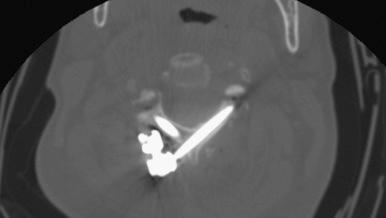Physical Address
304 North Cardinal St.
Dorchester Center, MA 02124
|
|
|
|
|
|
|
|
Bilateral crossing C2 translaminar screws can be an attractive option when contemplating fixation of the C2 vertebra (axis). The procedure is not technically demanding and provides rigid fixation. Traditional posterior wiring methods are also technically simple, but they are associated with suboptimal fusion rates resulting from limited stiffness. Translaminar screws are not as affected by variations in a patient’s anatomy and do not risk injury to the vertebral arteries, unlike other technically demanding C2 screw fixation options (C1-C2 transarticular screws, C2 pedicle screws).
In an attempt to reduce the risk of injury to the vertebral artery during placement of the C2 pedicle screw, the C2 pars interarticularis fixation, which uses a shorter screw (14 to 16 mm) and a slightly different trajectory, has been suggested to be less risky to the vertebral arteries than longer pedicle screw placement. However, the biomechanical strength of the C2 pars screw has not been proven, and anatomic variations may also prevent placement of this screw. Therefore, developing an understanding of the anatomy and technique for placement of C2 translaminar screw fixation can provide an additional method for rigid fixation of the axis that may be incorporated with occipitoatlantal or subaxial instrumentation. The goal of this chapter is to review preoperative considerations, surgical technique, and results for the placement of C2 translaminar screw fixation.
The indications for surgery and the use of translaminar screws for stabilization of disorders of the cervical spine remain the same as for other cervical procedures. Although described more completely in other chapters, patients with myelopathy, radiculopathy, myeloradiculopathy, tumors, infection, or trauma with associated cervical instability are potential candidates.
The history and examination should include evaluation for standard signs and symptoms of myelopathy or radiculopathy. Motor weakness, sensory deficits, and reflex changes can help identify the disorder. In addition to the standard history and examination, particular attention should also include evidence of previous posterior cervical spinal surgical procedures or congenital abnormalities that may have resulted in the resection or absence of the C2 lamina, which could preclude the use of translaminar screws. In addition, a search for subtle examination findings such as a low-lying hairline, webbed neck, and decreased range of motion can identify abnormalities such as Klippel-Feil syndrome. This syndrome is associated with congenitally fused cervical segments and frequently with occipitalization, and it may alter the surgical technique selected.
Imaging studies should start with plain radiographs and include cervical spine anteroposterior, lateral, and flexion and extension dynamic imaging studies to assess overall alignment, degenerative disease, osteophytes, range of motion, and stability.
Advanced imaging, in the form of magnetic resonance imaging (MRI), can provide information about the intervertebral disks, cranial and spinal nerve roots, supporting ligaments, presence of a syrinx, Chiari malformation, and information on the spinal cord caliber and quality, among other things. Although MRI is typically the imaging study of choice for identifying disease, the addition of a computed tomography (CT) scan, with or without a myelogram, can be particularly useful when deciding to place translaminar screws.
The CT scan can help provide additional information about the presence and extent of the bony compression, presence of ossification of the posterior longitudinal ligament (OPLL), and in revision cases, presence of a solid fusion or pseudarthrosis. More specifically, with regard to translaminar screws, preoperative CT imaging of the cervical spine is important to ensure that a patient’s anatomy can accommodate a screw (length and width) before screw placement is attempted ( Fig. 41-1 ).

Become a Clinical Tree membership for Full access and enjoy Unlimited articles
If you are a member. Log in here